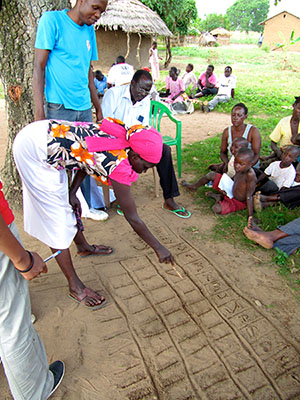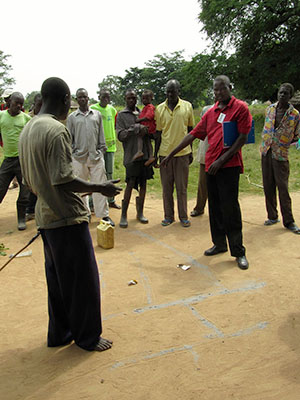Research Highlight |
Policy meets Practice: Reflections on Participatory Climate Change Adaptation |
I began my work by refining the VCA data collection tools and building databases to store the data. Afterward my colleagues and I put on a one-week training for the volunteers, and I began bouncing around Teso and Karamoja, visiting villages, and supporting the volunteers in data collection, systematization, and analysis. As an aspiring policy analyst I was particularly interested in how policies translate to the field. Observing the VCA process was an excellent reminder of how what ought to be is often complicated by what is (thanks to Michael Glantz for introducing me to E.H Carr’s framework). In the implementation phase, idealized plans meet reality. |
Volunteers and community members in Katakwi practicing the seasonal calendar tool. |
The experience taught me a lot about the general challenges facing participatory development or climate change adaptation projects. Keeping the community’s attention through all nine VCA activities is not simple. It is easy to assume that the poor will be grateful for any intervention and enthusiastically attend day after day of community meetings. However, community participants have farms, livestock, and other livelihood activities to attend to. Initial enthusiasm for the meetings wanes, especially in the absence of immediate returns. Most communities had worked with NGOs in the past, and they were understandably protective of their time. During meetings, many people expressed their frustrations at past interactions (with other NGOs or with government development officers) and what they believe were broken promises, corrupt processes, and benefits that never materialized. Because people have expectations and other obligations, the volunteers were under tremendous pressure to provide some kind of immediate gratification. This, however, runs contrary to the purpose of a VCA, which is to mobilize communities to identify and contribute to solving their own problems. Providing food, sodas, or other incentives can easily undermine sustainability, as people participate for the immediate reward and fail to become invested in the process and the outcomes. In addition to these challenges, I also observed several strengths of the VCA model. The use of local volunteers, who speak the local language and understand local customs, is essential. Over 40 languages are spoken in Uganda, and more than one is sometimes spoken in a single village. Because most volunteers come from the regions in which they work, they are able to communicate effectively and to adapt VCA tools to the local context in ways that outsiders could not. It was impressive to observe the Red Cross network and to see how many volunteers they could mobilize with so few resources. |
|
One question that remains for me is whether the community process truly generates a better understanding of local problems and solutions. During the review process with the volunteers, I was struck by the fact that the problems facing villages were quite similar, despite notable differences in geography and other characteristics. It may be that communities in Teso and Karamoja truly face the same problems, but it could also be that Red Cross volunteers and staff unconsciously shape the process in subtle ways. I have not yet finished reviewing the district reports and writing up my final summary, but I will be curious to see how similar the community actions plans are. Whether or not the VCA process leads to more specialized knowledge of specific villages, I hope the process of jointly assessing community vulnerabilities and capacities was valuable to community participants and will foster engagement in the project. Thanks to the ENVS program for an amazing summer. I learned a lot and made excellent contacts, which will help me with my future research. In particular, I hope to work on this project again, helping the Red Cross to design a monitoring and evaluation system for the use of forecasts as part of my dissertation. Arielle tozier delapoterie |
Practicing hazard and resource mapping in the community. |


 I had an incredible summer working with the Ugandan and German National Societies through the Red Cross Red Crescent Climate Change Internship Program. I was assigned to a six year climate change adaptation project that incorporates elements of livelihood support, disaster risk reduction, and—most exciting to those working on the project—a preparedness fund that will disperse funds for drought and flood response before disasters actually occur. As the project was in its early stages (the first 6 months) I was charged with helping to oversee baseline data collection in what the Red Cross calls a Vulnerability and Capacity Assessment (VCA).
I had an incredible summer working with the Ugandan and German National Societies through the Red Cross Red Crescent Climate Change Internship Program. I was assigned to a six year climate change adaptation project that incorporates elements of livelihood support, disaster risk reduction, and—most exciting to those working on the project—a preparedness fund that will disperse funds for drought and flood response before disasters actually occur. As the project was in its early stages (the first 6 months) I was charged with helping to oversee baseline data collection in what the Red Cross calls a Vulnerability and Capacity Assessment (VCA).
